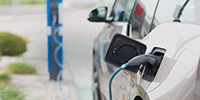How to determine battery type and battery life
Learn how a lead acid battery works, more about battery maintenance and the difference between flooded, AGM and gel batteries. Read the tutorial today.
Types of Batteries
Batteries are divided in two ways, by application (what they are used for) and construction (how they are built). The major applications are automotive, marine, and deep-cycle. Deep-cycle includes solar electric (PV), backup power, traction, and RV and boat "house" batteries. The major construction types are flooded (wet), gelled, and sealed AGM (Absorbed Glass Mat). AGM batteries are also sometimes called "starved electrolyte" or "dry"because the fiberglass mat is only 95% saturated with Sulfuric acid and there is no excess liquid.
Flooded may be standard, with removable caps, or the so-called "maintenance free" (that means they are designed to die one week after the warranty runs out). All AGM & gelled are sealed and are "valve regulated", which means that a tiny valve keeps a slight positive pressure. Nearly all sealed batteries are "valve regulated" (commonly referred to as "VRLA" - Valve Regulated Lead-Acid). Most valve regulated are under some pressure - 1 to 4 psi at sea level.
Battery Lifespan
The lifespan of a deep cycle battery will vary considerably with how it is used, how it is maintained and charged, temperature, and other factors. It can vary to extremes - we have seen L-16's killed in less than a year by severe overcharging and water loss, and we have a large set of surplus telephone batteries that see only occasional (10-15 times per year) heavy service that was just replaced after 35+ years. We have seen gelled cells destroyed in one day when overcharged with a large automotive charger. We have seen golf cart batteries destroyed without ever being used in less than a year because they were left sitting in a hot garage or warehouse without being charged. Even the so-called "dry charged" (where you add acid when you need them) have a shelf life of 18 months at most. (They are not totally dry - they are actually filled with acid, the plates formed and charged, then the acid is dumped out).
These are some typical (minimum-maximum) expectations for batteries if used in deep cycle service. There are so many variables, such as depth of discharge, maintenance, temperature, how often and how deep cycled, etc. that it is almost impossible to give a fixed number.
Starting: 3-12 months
Marine: 1-6 years
Golf cart: 2-7 years
AGM deep cycle: 4-8 years
Gelled deep cycle: 2-5 years
Deep cycle (L-16 type etc): 4-8 years
Rolls-Surrette premium deep cycle: 7-15 years
Industrial deep cycle (Crown and Rolls 4KS series): 10-20+ years.
Telephone (float): 2-20 years. These are usually special purpose "float service", but often appear on the surplus market as "deep cycle". They can vary considerably, depending on age, usage, care, and type.
NiFe (alkaline): 5-35 years
NiCad: 1-20 years
Didn’t you find the answer you were looking for? Please e-mail us at: info@bullsbattery.com













